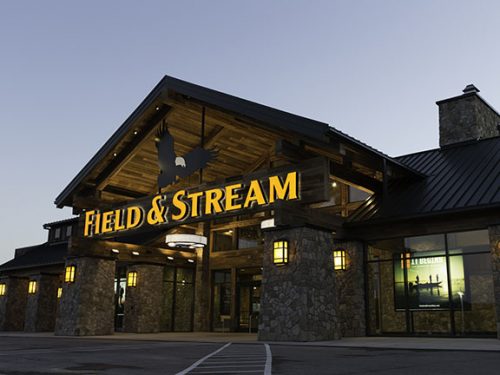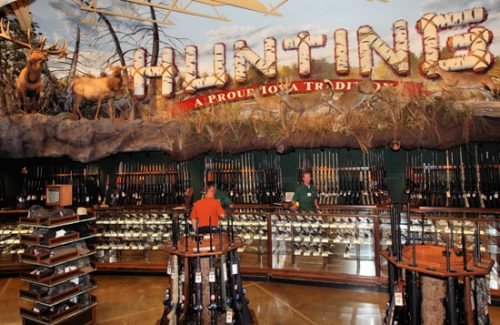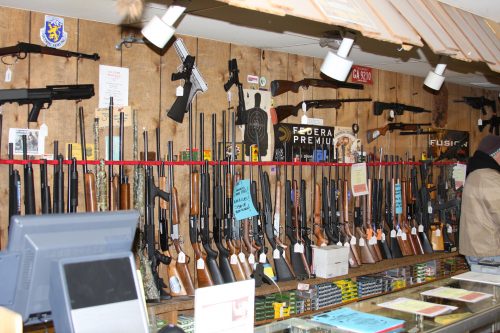
In response to the events from last month and the proposed measures in Congress, some retail giants have already put their own store policy reforms into place. Earlier this month, Dick’s Sporting Goods announced that it would no longer sell military-style semi-automatic rifles or high-capacity magazines and it will require customers to be at least 21 years old to purchase any firearms at its stores (federal law allows 18 year olds to purchase semiautomatic rifles and other non-handgun firearms). Walmart, which had already ended sales of the AR-15 weapon and other modern sporting rifles in 2015, announced that it would also be requiring customers to be at least 21 years old to purchase any firearms or ammunition.[i] But how will these reform policies, either self-imposed or by law, impact sales and stores of both retail giants and smaller retailers who sell these rifles?
The topic of gun control reform is one that is often discussed in Congress, though due to the highly partisan nature of the issue, no major reform laws have been passed in over two decades. This highly controversial reform occurred in 1994, when President Clinton signed the Violent Crime Control and Law Enforcement Act, which included the Public Safety and Recreational Firearms Use Protection Act (the assault weapons ban from 1994 to 2004).[ii] However, following the school shooting that took place on February 14th in Parkland, Florida that left 17 students and adults killed and others injured, several new gun reform laws are being seriously considered by both parties with more pressure than ever being on Congress by the American public to make reforms.
With Congress back in session last week, there are several proposed gun control reform laws for it to consider. Some of the major proposed reform laws include outlawing bump stocks (which allow semi-automatic weapons to fire rounds more rapidly), required use of the National Criminal Instant Background Check system, raising the legal age to purchase a rifle from 18 to 21, restricting gun magazine size to ten rounds or less, and banning AR-15 style weapons.[iii] The proposed ban of AR-15 style weapons, the type of weapon used in the Parkland, Florida school shooting last month, would be similar to the temporary ban on assault weapons President Clinton signed into law from 1994 to 2004, which failed to receive the required support for a renewal of the temporary law or a permanent law after 2004.

Dick’s Sporting Goods had already banned assault-style weapons in 2012 following the Sandy Hook school shooting, but it quietly began selling these weapons again only a few months later in its Field & Stream stores. While Dick’s Sporting Goods’ stock went up following the announcement last week, it is unclear how this change will impact its sales and its real estate holdings as firearms sales are a significant portion of the company’s revenues. In the past, we have seen how poor or stagnant gun sales have hit the company hard. Last August, Dick’s Sporting Goods’ shares declined 19%, their lowest level since 2010, due to a significant firearm sales decline after the election of Donald Trump.[iv] This is one example of the strong correlation between gun reform laws (or threats thereof) and reactionary firearms sales. After the announcements last week, Bass Pro Shops and Cabela’s (which is owned by Bass Pro Shops) are the only major retail brands still selling assault-style rifles in their 160+ stores nationwide. While they are currently receiving backlash due to their lack of reforms, it is highly possible that they may benefit at least short-term from both Dick’s Sporting Goods and Walmart’s announcements and the proposed assault weapons ban due to consumer stockpiling of these weapons, but long-term an actual ban would impact sales significantly. It is also unclear if this retail giant (or other retailers) may benefit from sales of the remaining stock of assault-style weapons owned by Dick’s Sporting Goods, as it has not been reported what the company plans to do with these items.
As Dick’s Sporting Goods had only been selling these items in its Field & Stream stores in the past few years, the impact to its physical real estate holdings on its self-imposed ban is likely to be contained to these 35 stores. The removal of this large portion of its Field & Stream stores likely means redesigns to the stores’ layouts, and potentially the closure of these stores if the loss of these firearms sales is significant enough. Bass Pro Shops and Cabela’s may also have to make similar store layout changes should the ban pass, and lost sales could also impact the growth of these retailers.

While the impact to retail giants of this ban are likely to be significant, it is important to note that only 5% of gun sales in the United States are controlled by the four largest gun sellers, meaning many of the smaller retailers, especially those that only sell guns, may be hit even harder by the ban. As of 2017, the United States had an estimated 6,804 gun shops generating $8.6 billion in revenue.[v] There were, however, 56,754 federally licensed firearms dealers as of 2016, as well as 8,076 pawnbrokers that are allowed to sell guns. Individuals are also able to sell firearms at shows and event spaces throughout the country. Due to the highly protective nature of consumers of firearms, data for individual retailers’ gun sales is not available from the Bureau of Alcohol, Tobacco, and Firearms (ATF). A 2010 survey of consumers by the National Shooting Sports foundation indicated that only 25% of consumers purchased their most recent “modern sporting rifle” online, and only 6% at a chain or big-box retailer, meaning the majority purchased it through an independent retail store or individual. The likely large percentage of sales incurred at these independent retail stores means that many of these stores may be completely redesigned, scaled back, or shut down should the assault-style rifle ban pass.
With so much of the data for guns sales being protected, it is difficult to predict exactly how much sales and real estate holdings will be impacted across retailers of all sizes, but it is likely that there will be changes for both the retail giants and independent retailers. It is likely that both retail categories will experience changes to store layouts, shifts in sales figures, and, for some, store closures. For now, however, it is up to Congress to determine their fate.
[i] Dwyer, C., Domonoske, C., & Sullivan, E. (2018, February 28). Walmart Joins Dick’s Sporting Goods In Tighter Limits On Gun Sales. Retrieved March 04, 2018, from https://www.npr.org/sections/thetwo-way/2018/02/28/589436112/dicks-sporting-goods-ends-sale-of-assault-style-rifles-citing-florida-shooting
[ii] Gray, S. (2018, February 22). A Timeline of Gun Control Laws in The U.S. Retrieved March 03, 2018, from http://time.com/5169210/us-gun-control-laws-history-timeline/
[iii] Diaz, D. (2018, February 26). 5 things Congress could do on guns. Retrieved March 03, 2018, from https://www.cnn.com/2018/02/25/politics/gun-control-congress-proposals-marco-rubio-parkland-school-shooting/index.html
[iv] Wahba, P. (2017, August 15). Dick’s Sporting Goods Takes Hit as Gun Sales Fall. Retrieved March 03, 2018, from http://fortune.com/2017/08/15/dicks-sporting-goods-rifles/
[v] Bomey, N. (2018, February 28). Could Dicks Sporting Goods ban on assault-style rifles change sales? Retrieved March 04, 2018, from https://www.usatoday.com/story/money/2018/02/28/dicks-sporting-goods-assault-style-weapons/381618002/
